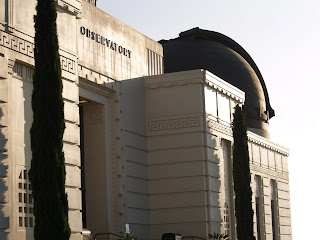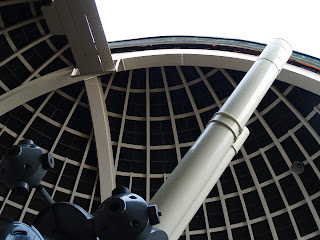After a week of sailing to Catalina Island and back, I took a detour to north LA. Griffith J Griffith on December 16, 1896, donated 3,015 acres of Rancho Los Felis to the City of Los Angeles in order to create a public park in his name. He bought Los Feliz after making his fortune in Mexican silver. Before his death in 1919 he donated $100,000 to establish an observatory for the public. Finally built in 1935 at the height of the depression. The finest materials and craftsmen were a bargain during this time. 2 million visitors a year passed through up until 2002 when a restoration and expansion was begun. Closed for four years when re-opened it was like new, but looked exactly the same from the outside as 1935.
Lots of movies have been filmed here. I didn't get a picture of James Dean's Bust, but Rebel Without a Cause filmed several scenes here including the famous parking lot fight. Strangely, Dean had seen a bust of Marlon Brando and wanted one for himself. He commissioned the artist the night of his death.
Astronomers' Monument built with PWPA New Deal (public works of art project) funds. LA Commissioned six local artists to do the six greats: Hipparchus, Copernicus, Galilei, Kepler, Newton, and Herschel. One of the artists, George Stanley, also did the "Oscar" statuettes.
The old LA Police Building stands out.
Downtown of a smoggy day.
Good place to bring a date.
"Camera Obscura-[ Latin for Dark Room] A Camera Obscura is a basic observing tool that uses mirrors and lenses to focus light onto a flat surface. Griffith Observatory's new Camera Obscura is a larger and more capable version of a previous exhibit. The current version features a periscope-like tube on the east side of the Observatory's roof , which reflects images down onto the Camera Obscura table. With its continuously rotating tube, the Camera Obscura provides a spectacular 360°- field view of Los Angeles vistas and reminds visitors that they have reached an observational junction of earth and sky. The Observatory's new Camera Obscura instrument was built by George Keene."- Griffith Website.
"The genesis of Griffith Observatory's public telescope occurred when Griffith J. Griffith was invited to visit to Mount Wilson Observatory, then home to the world's largest operating telescope, the 60-inch reflector. While there, he was given the opportunity to view a celestial wonder through the telescope. Profoundly moved by the experience, Griffith seized on the idea of constructing a public observatory with a telescope that could be used by all residents of Los Angeles. He specified in his will that the telescope was to be "at least 12-inches in diameter" and "complete in all its details" and was to be located "high and above the Hall of Science." In 1931, the Griffith Trust ordered the telescope from the Carl Zeiss Company of Jena, Germany; the $14,900 spent on the instrument was the first purchase of material for Griffith Observatory."-Griffith Website.
The Samuel Oschin Planetarium roof. In 1935 this was the third Planetarium built in the US. After reconstruction the finest in all the Universe!
More chances to view Los Angeles below.
See the people on the roof, waiting for their turn on the 12-inch.
Sky parties were cut short due to marine layer that sank in, though I saw Vega, Saturn, and the Moon before the clouds came. Vega was seen through the 12-inch Ziess during daylight, amazing!
The Moon over Griffith.
At last, rush hour is over for the night trip home.






















